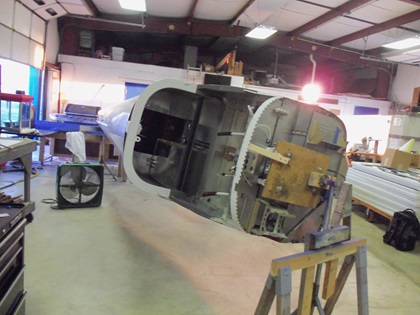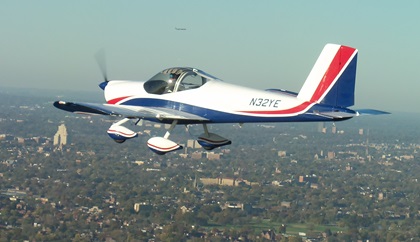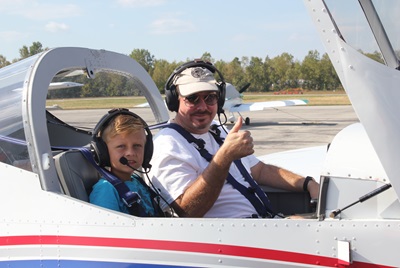When most clubs in formation discuss what type of aircraft to operate, there’s a good chance the founding members are thumbing through Trade-a-Plane or Barnstormers online to find an airplane that will meet the club’s mission. Both the Frederick Sport Flyers Flying Club based in Frederick, Maryland and the Spirits of Aviation Flying Club based near St. Louis, Missouri chose a different route. They decided to build an airplane.
They decided to build an airplane.
Operating an experimental aircraft in a club environment has some advantages – whether your club builds the aircraft or buys it. One of the common missions among flying clubs is providing affordable access to aircraft. Homebuilt aircraft can be very economical to operate, in part because builders may do their own maintenance. In addition, many homebuilts have low operating costs.
If the club chooses to build an aircraft—like the Frederick Sport Flyers and Spirits of Aviation flying clubs did—the members will spend hundreds of hours together during the build. This time can naturally create strong bonds and develop a deep camaraderie that can be carried on through the club once the aircraft is completed.
Frederick Sport Flyers
The Frederick Sport Flyers was formed in 2008 by five members of the local EAA Chapter 524. “One night at a chapter meeting a question was brought up about a group of people building an airplane in the chapter,” Club President and EAA Chapter Member Jerry Blake said. “It progressed to where five of us decided to build an airplane, we bought the appropriate parts from Zenith and we built a Zodiac 601 XL-B over a five-year period.”
The club is totally separate from the EAA chapter. “We’ve incorporated as a separate entity through the Maryland business procedures,” Jerry said. It has a traditional leadership structure with a president, vice president, secretary and treasurer, and meets once a month.
 During the building process, the club invited members of the EAA chapter to help with the project, which helped strengthen the camaraderie in the club and the chapter. Since the project was finished in 2012, the club has put about 325 hours on the Zenith, primarily flying it locally for fun, although they did fly the plane to Oshkosh one year.
During the building process, the club invited members of the EAA chapter to help with the project, which helped strengthen the camaraderie in the club and the chapter. Since the project was finished in 2012, the club has put about 325 hours on the Zenith, primarily flying it locally for fun, although they did fly the plane to Oshkosh one year.
The club has since taken on a second aircraft project. This time it is a 1946 J-3 Cub that was found in a hangar at Frederick. It hadn’t flown in 17 years, and the engine had been taken off and stored on a pallet in the hangar.
The club members split the $9,000 purchase price and have been diligently disassembling the entire aircraft and rebuilding it to brand new condition. It is expected to fly this fall, at which point the club will reevaluate its fee structure.
Currently the club is limited to 6 members and the buy-in is $8,000. Dues are $150 a month and the hourly rate for the Zenith is $45 tach time, wet.
Spirits of Aviation
The Spirits of Aviation Flying Club was formed by six members of EAA Chapter 32 after Chapter President Dave Doherty attended a forum on starting a flying club while attending AirVenture in 2015. He came back from Oshkosh and raised the idea at a chapter meeting.
“I asked the membership if anyone would be interested in forming a flying club and building an airplane,” Dave said. “About six people were interested and a couple of other people joined in. It happened that we had just the right mix and it worked out great.”
The first thing Dave and his fellow club members did was set up the structure of the club. “We didn’t want to get too involved in it until we had some good guidelines and a good set of rules to follow,” Dave said. “The AOPA guidelines and EAA guidelines were a huge help.”
One of the biggest challenges was setting up the legal structure for the club and understanding what the state requires. Dave recommends getting assistance from someone knowledgeable about state laws. “The fellow that we used didn’t think the 501(c)7 was a great idea so we didn’t go that way, but now we wish we had,” Dave said. “I would suggest do it as a non-profit corporation from the start and also consider filing with the IRS for tax exemption.”
The club also drafted bylaws and operating procedures. Instead of the traditional officers, such as president, vice president, etc., the club has a “designated representative,” a financial officer, safety officer and during the build there was a project manager. “Once we got the procedures written and signed by everybody, then we proceeded with building the aircraft.”
The club chose the RV-12 in part because a tail kit had been donated to the EAA chapter. The club purchased the kit from the chapter and began building. Another reason the RV-12 was chosen was that many chapter members had built various RVs, and all spoke highly of the quality of the aircraft and support from Vans.
Choosing to Build an E-LSA or an E-AB
In building an RV-12 the club had a decision to make: would they build it as an Experimental Light Sport Aircraft (E-LSA) or an Experimental Amateur Built (E-AB)?
An E-LSA is a kit that is offered by a manufacturer that also has a version that it builds and sells. The advantage of building an E-LSA is there is no percentage requirement on how much must be built by the owner. When building an E-AB, an amateur must build 51 percent or more of the aircraft.
However, it also means the builder cannot make modifications like they can with an E-AB. They must build the E-LSA kit exactly as the manufacturer has designed. Another advantage of the E-LSA is that the Phase 1 flight test is only 5 hours, where an E-AB must be flown 40 hours to complete flight testing.

When it comes to maintenance, an E-LSA owner can do the annual condition inspection (which is what an annual for an experimental is called) by taking a two-day course and earning a repairman’s certificate. The original owner/builder of an E-AB may do their own maintenance without having to take a class to earn the repairman’s certificate.
Building the plane
The RV-12 is comprised of six or seven kits. The club worked on one kit at a time on an incremental basis – starting with the tail, then the fuselage, wings, finishing kit, engine and firewall forward, the interior and then avionics last. The build time was between 800 and 1,000 hours and took about 14 months. "Divide that by six people and it’s not so bad," Dave said.

Of the six club members, each person had an area of specialty. “We were fortunate that we had someone in all the different disciplines of aircraft systems,” Dave said. “I was in sheet metal my entire career so I could do all the sheet metal stuff without a problem. And we shared all that knowledge with each other and learned a lot from each other.”
In addition to the six club members, other EAA chapter members worked on the plane. “The chapter is a great resource for tools, and the pool of knowledge in the EAA chapter is invaluable,” Dave said. 
The kit came with a Rotax engine and for avionics the club had several choices. They considered Garmin and Dynon, and chose the Dynon SkyView system because of Dynon’s experience with glass cockpits in experimental aircraft. The plane was finished in August 2016 and the club has had good use out of it. In about three years, the club has flown 780 hours in the plane.
Finances
The six founding members split the costs of building the aircraft and getting the club up and running, which was about $90,000. Each member owns a 1/6th share of the aircraft, which works out to about $15,0000 a share. If a member wants to leave, they are responsible for selling their share at whatever price they can negotiate.
Once you get past the buy-in, the operating costs are low. There are no monthly dues and members pay $10 an hour, Hobbs time, dry. The aircraft uses MOGAS, which is currently about $2.70 a gallon in the St. Louis area compared with $4.25 a gallon for Avgas. Fixed costs, such as insurance and hangar rental, are split equally among the six owners.
 Maintenance
Maintenance
The main advantage of operating a homebuilt is the ability to do your own maintenance. To work on an E-LSA, an owner needs to take a two-day course and earn a repairman’s certificate. For an E-AB, the owner may work on the aircraft without taking the course but does have to apply for the rating.
Building Bonds for Life
EAA Chapter 32 has about 90 members, and although Dave was the Chapter president, he didn’t know the other club members very well before starting the RV-12 project.
“Once we got into the building phase, then we really got to know each other,” he said. “We generated friendships that I think will last the rest of our lives. The building process itself brings you a lot closer together with an understanding of which person is capable of what, so when you do have maintenance issues, I know Bob is our electronics whiz so I’ll consult him and I’ll go to different people for other stuff as they are the specialists in that portion of the systems.”
 Camaraderie is central to any good flying club, and choosing to build an aircraft only strengthens those bonds. It’s an opportunity to choose an aircraft that meets the club’s mission, develop an intimate knowledge of the aircraft and its systems, and have an economical plane to share in a club environment for years to come. “The build process is a huge asset in forming friendships with each other,” Dave said. The experience of building the plane and forming a club around it “really introduced a lot of people to the joy of flying.” Isn’t that what flying clubs are all about?
Camaraderie is central to any good flying club, and choosing to build an aircraft only strengthens those bonds. It’s an opportunity to choose an aircraft that meets the club’s mission, develop an intimate knowledge of the aircraft and its systems, and have an economical plane to share in a club environment for years to come. “The build process is a huge asset in forming friendships with each other,” Dave said. The experience of building the plane and forming a club around it “really introduced a lot of people to the joy of flying.” Isn’t that what flying clubs are all about?
Factsheets
Frederick Sport Flyers Flying Club
|
Location |
Frederick Municipal Airport (KFDK), Frederick, MD |
|
Website |
None |
|
|
None |
|
Year formed |
2008 |
|
Aircraft |
2013 Zenith 601 XL-B ($45/hr) / Rates are Tach time, wet |
|
Joining fee |
$8,000 |
|
Monthly dues |
$150 |
|
Membership |
6 owner members |
|
Scheduler |
None |
Spirits of Aviation Flying Club
|
Location |
St. Charles County Smartt Field Airport (KSET), Portage Des Sioux, MO |
|
Website |
None |
|
|
None |
|
Year formed |
2015 |
|
Aircraft |
2016 RV-12 E-LSA($10/hr) / Rates are Hobbs time, dry |
|
Joining fee |
1/6 – share sold at owner’s discretion. |
|
Monthly dues |
None |
|
Membership |
6 owner members |
|
Scheduler |
Google Calendar |